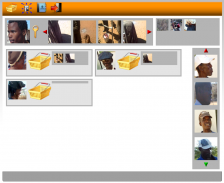Sprachrohr aus der Hölle…
Entwicklung einer Video Wissensplattform für die Namibische Landbevölkerung
Development of a Video Knowledge Platform for Namibian Rural Communities.
Sorry this page is only available in (my bad) English. 🙂
I was often asked what i did as my bachelor thesis. So here is a short description of the project, the idea, and what we did so far.
About the Project
The project is a collaboration between 4 universities. The Polytechnic of Namibia as the initiator of the project, Aalborg University in Denmark, the University of Cape Town and the South-Westphalia University of Applied Sciences in Germany. The goal of the project is to produce several prototypes of a video-platform which then should be tested „in the wild“. Research should be done on how good the implementation fits the needs of the villagers, where improvements could be done and what has to be implemented in future versions (additional features).[1]
The reason for the project is, that the young villagers often migrate into the cities, leaving their traditions and all the knowledge of the elders behind. Due to the fact, that the rate of illiterates is very high, and the language spoken is sometimes nearly not documented in a written form[2] the knowledge should be conserved in videos giving the elders the opportunity to transfer their knowledge to future generations.
The Idea
Our Idea was to create a web-based platform based on the feedback of a prototype done before. The logic should be provided by a XML-RPC server to allow different future GUI implementations. The new specifications said that the prototype should work without any textual input. Everything had to be done by clicking on proper icons.
The hard part was to map the new workflow specifications:
The user:
- should be able to share videos among other villagers.
- should be able to lock videos.
- and should be able to create video-lists.
What we did so far
We rewrote the whole web-interface to cover all the specifications we received. All textual input was exchanged by icons or removed to reduce irritations. Every page now had a sound file describing what to do on that page to the user. The picture shows how the interface for the video sharing now looked like.
The logic was removed from the website and is now completely handled by the server. During a test which we did in the village the villagers had less hesitations to interact with this interface than they have shown in a test with the previous textual interface. Even though this interface wasn’t perfect it covered the natural setup much better. Some improvements have been discussed afterwards and will now be implemented in a future prototype.
Literature:
[1] Chivuno-Kuria, S., Kapuire, G. K., Bidwell, N. J., & Winschiers-Thophilus, H. (2010). Determining requirements within an indigenous knowledge system of African rural communities. Paper presented at SAICSIT ’10, October 11-13, 2010, Bella Balla, South Africa., http://hdl.handle.net/10628/257
[2] Example: The Nama Language, http://en.wikipedia.org/wiki/Nama_language
Further Information / Background:
Kapuire, Gereon Koch, Heike Winschiers Theophilus, Shilumbe Chivuno Kuria, Nicola J Bidwell and Edwin Blake (2010) A revolution in ICT, the last hope for African Rural Communities‘ technology appropriation. In Proceedings International Development Informatics Association Conference (IDIA2010), Cape Town, South Africa . http://pubs.cs.uct.ac.za/archive/00000640/
